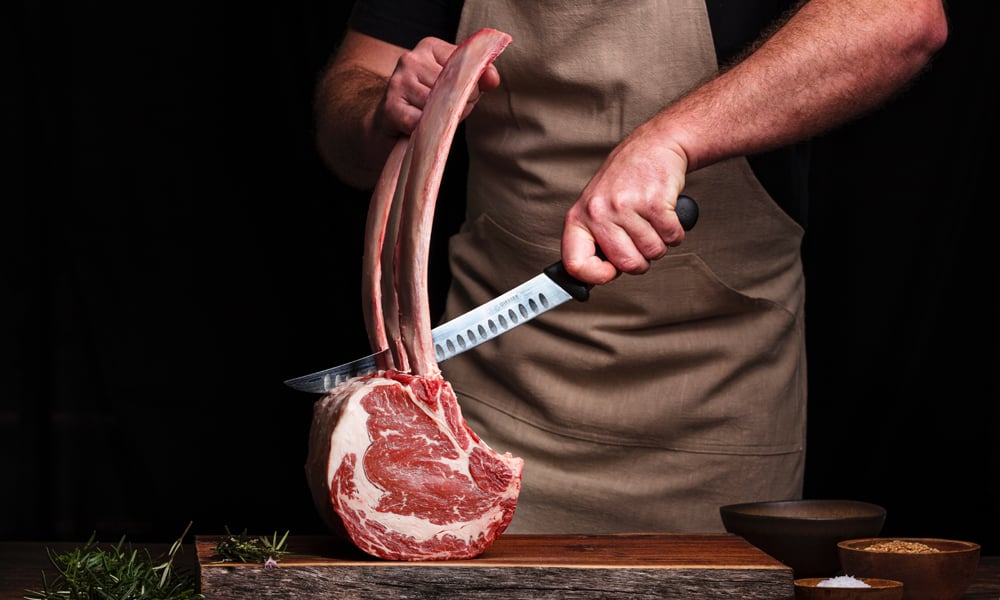The culinary world churns through trendy dishes with remarkable speed. It wasn’t that long ago that wagyu beef was all the rage in high-end restaurants. The current darling of both foodies and chefs appears to be the bombastic tomahawk steak. You’ve likely seen posts pop up on your social media feeds with customers wielding this premium cut of steak like its namesake weapon. But how did the tomahawk steak become so popular? And why is it so damn expensive? With tomahawk steaks in the spotlight for the moment, we thought we should get at least a little educated on them. And not just quick-Google-search educated. We wanted to get expert advice from a real-life human. So we did.
Our guy writing this article is based in Wilmington, Delaware, so he talked to local butcher John Eleutheriou at Haldas Market to learn all there is to know about tomahawk steaks. They’ve been serving the area for more than a century, which we’d say imbues him with a certain amount of firsthand and inherited expertise. He had a lot of good stuff to say about tomahawk steaks and an endearing, matter-of-fact way of saying it. We learned a lot from the guy and we’ll do our best to pass along his knowledge. So welcome to the pricey and maybe overhyped world of tomahawk steaks.
An Expert’s Guide to Tomahawk Steaks
The baseline John established almost as soon as our conversation started was that a tomahawk is a very good cut of meat but it’s as popular as it is mostly due to its visual appeal. That’s pretty much it. Parade rained on, thunder stolen. The tomahawk steak is a high-quality, good-looking steak with an inflated price tag.
We were a bit taken aback by his honesty. It’s a tomahawk steak, for Pete’s sake! Everyone talks about it like it’s the ultimate cut of meat. A thick, juicy, tender, flavorful steak attached to a caveman’s ax handle. How could its quality be exaggerated? But the more specific John got, the more his answer (and mild cynicism) made sense.

What’s So Special About Tomahawk Steaks?
From a technical perspective, a tomahawk and a ribeye are practically identical. The meat for both steaks comes from the same part of the cow and has a big chunk of bone attached. They both cook the same, cut the same, and eat the same. It’s just that a tomahawk steak has that extra two-foot section of rib sticking off of it. That means the tomahawk is a conscious stylistic choice, not a revelatory or epiphany-inducing cut of meat off a tiny little rare part of the cow.
Not that technical identicality is going to stop a restaurant from marketing their food. Restaurants and steakhouses, and the chefs in them, needed a dish that would get heads turning. The tomahawk fulfills that perfectly. Similar to how everyone looks over when they see a waiter walking by with a fajita pan, people in a steakhouse will stare as the waiter carts out the tomahawk steak. Then everyone in the place is going to talk about the lucky bastard who got it.
In fact, John got even more specific inside his restaurant example. He identified large corporations as the main generator of the buzz. They want to make as distinct an impression on potential customers as they can. A quick and easy way to do it is by treating whomever they’re courting to a big juicy tomahawk, with the added bonus that everyone else in the building knows how good they are at business. Because ultimately, that’s what a tomahawk steak is: a showy cut of meat that, while good, doesn’t always live up to the hype.
Ultimately, though, he said the real appeal of the tomahawk kicks in strongest when someone else is paying for it, which is probably why it’s not one of his biggest sellers. In fact, they’re not even always in stock at Haldas. John will keep them around for holidays or special events and he mentioned Valentine’s Day and Mother’s Day as times that he moves the most. Beyond that, people impulsively buying tomahawk steaks will have to hope one of his regulars asked for them recently.
Where to Buy Tomahawk Steaks
If you’re ever in North Wilmington, Delaware, and decide to go to Haldas to pick up a steak, expect to pay $26.99 a pound. Since most of you aren’t in North Wilmington, we recommend finding your own local butcher. They’re always your best bet for high-quality meat.
John didn’t ask us to defend mom and pop butchers, by the way. That’s just us saying we should all be taking better care of our community shops. That said, we also already mentioned Haldas doesn’t always have tomahawk steaks in stock. We’d imagine that’s also true of other places. If you absolutely need one right this second, there are a handful of online retailers.
Meat the Butchers has them for a measly $104.95 for a 32oz cut.
The Chicago Steak Company can get them to you for $199.95. That’s the sale price for two 30oz tomahawks. Otherwise, expect to pay $250.
Of course, Amazon will sell them to you for $1,225.95 for a five-pack of steaks, with each individual steak weighing in between 2.5 and 3.5 pounds.
The always reliable Omaha Steaks can get two of them to you for $200 even. A bargain if we’ve ever seen one.
We’ve also picked a few tomahawks at Costco on a rare occasion. Their online offering comes in at $329.99 for four, which would make it roughly $34.74 per pound. We also know we’ve seen them in their store butcher a couple of times. We’re pretty sure it was cheaper, but that might just have been because it was a two-pack.
How to Cook Tomahawk Steaks
Now, you’ve decided to buy into the hype and get yourself a tomahawk steak, even after John gave us all that helpful advice. You’re not doing anything wrong. We’ve done it ourselves. The tomahawk is a beautiful cut of meat and its allure is undeniable. Remember, the first things John talked about were its quality and visual appeal.
Funnily enough, John has never cooked himself a tomahawk. We figured he’d at least have snuck one home one night, especially considering the wholesale discount we assumed he’d get. But no, John prefers to sell them to customers. We can’t fault him for his business sense. And he’s had ribeye, in any case.
Even so, he did have one tomahawk cooking tip. In his experience, normal people can find tomahawks a little overwhelming to cook for the same reasons they find them so attractive in restaurants. The bone comes with some logistical challenges and the thick cut of meat can be an overwhelming meal for one person. According to John, a regular person should expect their tomahawk to feed at least two people, if not three or four.
For some general cooking guidelines, check out Kansas City Steaks’ guide to tomahawks. They have four major methods on that page:
- On the grill,
- In the oven,
- Stovetop skillet with an oven finish,
- And the professional reverse sear.
Any of those four will yield you a delicious steak and all of them make room for you to add your own favorite seasonings.
If you want some more specific recipes, we have a few picks.

Recipe #1 Pan-Seared, Oven Finished Tomahawk
The Spruce Eats is generally good for some reliable, no-frills recipes and their tomahawk recipe doesn’t disappoint. They have you wrapping the bone in a damp paper towel and tinfoil, then searing the crap out of the tomahawk for a few quick minutes on each side before finishing it in the oven. While you’re finishing it, there’s also a delicious roasted garlic and thyme butter baste to make.
Recipe #2 Tomahawk Steak with Cowboy Butter
Make no mistake, we’re here for the cowboy butter. It’s a custom seasoned butter that incorporates garlic, shallot, parsley, horseradish, dijon mustard, and lemon juice. It’s not a combination we ever would have come to ourselves, but we’re glad someone did.
Recipe #3 Smoked Tomahawk Steak
There doesn’t seem to be anything that smoking (as a cooking method) doesn’t improve, tomahawk steaks not excluded. This recipe doesn’t exclusively use smoke, as it does end with a reverse sear in a cast-iron skillet. But the reverse sear certainly seems to be the move lately, so it’s not out of place. Besides, most of the flavor is coming from the smoke and the perfect seasoning.







